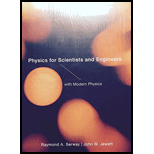
Concept explainers
A cyclotron (Fig. 28.16) designed to accelerate protons has an outer radius of 0.350 m. The protons are emitted nearly at rest from a source at the center and are accelerated through 600 V each time they cross the gap between the dees. The dees are between the poles of an
(a)
The frequency of the proton.
Answer to Problem 27P
The frequency of the proton is.
Explanation of Solution
Given Info: The accelerating voltage is
The formula for the frequency is,
Here,
Substitute
Thus, the frequency of the proton is.
Conclusion:
Therefore, the frequency of the proton is.
(b)
The exit speed of the proton.
Answer to Problem 27P
The exit speed of the proton is.
Explanation of Solution
Given Info: The accelerating voltage is
The formula for the speed is,
Here,
Substitute
Thus, the exit speed of the proton is.
Conclusion:
Therefore, the exit speed of the proton is.
(c)
The maximum kinetic energy.
Answer to Problem 27P
The maximum kinetic energy is
Explanation of Solution
Given Info: The accelerating voltage is
The formula for the kinetic energy is,
Substitute
Thus, the maximum kinetic energy is
Conclusion:
Therefore, the maximum kinetic energy is
(d)
The number of revolutions.
Answer to Problem 27P
The number of revolutions are
Explanation of Solution
Given Info: The accelerating voltage is
The formula for the number of revolutions is,
Substitute
Thus, the number of revolutions are
Conclusion:
Therefore, the number of revolutions are
(e)
The time of acceleration.
Answer to Problem 27P
The time of acceleration is
Explanation of Solution
Given Info: The accelerating voltage is
The formula for the number of revolutions is,
Substitute
Thus, the time of acceleration is
Conclusion:
Therefore, the time of acceleration is
Want to see more full solutions like this?
Chapter 29 Solutions
Physics For Scientists And Engineers With Modern Physics, 9th Edition, The Ohio State University
Additional Science Textbook Solutions
College Physics: A Strategic Approach (3rd Edition)
Biology: Life on Earth (11th Edition)
Laboratory Experiments in Microbiology (12th Edition) (What's New in Microbiology)
Fundamentals Of Thermodynamics
Brock Biology of Microorganisms (15th Edition)
Cosmic Perspective Fundamentals
- Help me make a visualize experimental setup using a word document. For the theory below.arrow_forwardHow to solve this, given answerarrow_forwardThree point-like charges are placed at the corners of a square as shown in the figure, 28.0 cm on each side. Find the minimum amount of work required by an external force to move the charge q1 to infinity. Let q1=-2.10 μC, q2=+2.40 μС, q3=+3.60 μC.arrow_forward
- A point charge of -4.00 nC is at the origin, and a second point charge of 6.00 nC is on the x axis at x= 0.820 mm . Find the magnitude and direction of the electric field at each of the following points on the x axis. x2 = 19.0 cmarrow_forwardFour point-like charges are placed as shown in the figure, three of them are at the corners and one at the center of a square, 36.0 cm on each side. What is the electric potential at the empty corner? Let q1=q3=+26.0 µС, q2=-28.0 μC, and q4=-48.0μc Varrow_forwardPLS HELparrow_forward

 Modern PhysicsPhysicsISBN:9781111794378Author:Raymond A. Serway, Clement J. Moses, Curt A. MoyerPublisher:Cengage Learning
Modern PhysicsPhysicsISBN:9781111794378Author:Raymond A. Serway, Clement J. Moses, Curt A. MoyerPublisher:Cengage Learning Principles of Physics: A Calculus-Based TextPhysicsISBN:9781133104261Author:Raymond A. Serway, John W. JewettPublisher:Cengage Learning
Principles of Physics: A Calculus-Based TextPhysicsISBN:9781133104261Author:Raymond A. Serway, John W. JewettPublisher:Cengage Learning Physics for Scientists and Engineers with Modern ...PhysicsISBN:9781337553292Author:Raymond A. Serway, John W. JewettPublisher:Cengage Learning
Physics for Scientists and Engineers with Modern ...PhysicsISBN:9781337553292Author:Raymond A. Serway, John W. JewettPublisher:Cengage Learning College PhysicsPhysicsISBN:9781305952300Author:Raymond A. Serway, Chris VuillePublisher:Cengage Learning
College PhysicsPhysicsISBN:9781305952300Author:Raymond A. Serway, Chris VuillePublisher:Cengage Learning Glencoe Physics: Principles and Problems, Student...PhysicsISBN:9780078807213Author:Paul W. ZitzewitzPublisher:Glencoe/McGraw-Hill
Glencoe Physics: Principles and Problems, Student...PhysicsISBN:9780078807213Author:Paul W. ZitzewitzPublisher:Glencoe/McGraw-Hill





